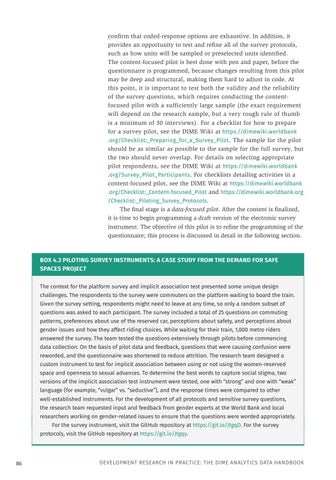confirm that coded-response options are exhaustive. In addition, it provides an opportunity to test and refine all of the survey protocols, such as how units will be sampled or preselected units identified. The content-focused pilot is best done with pen and paper, before the questionnaire is programmed, because changes resulting from this pilot may be deep and structural, making them hard to adjust in code. At this point, it is important to test both the validity and the reliability of the survey questions, which requires conducting the content- focused pilot with a sufficiently large sample (the exact requirement will depend on the research sample, but a very rough rule of thumb is a minimum of 30 interviews). For a checklist for how to prepare for a survey pilot, see the DIME Wiki at https://dimewiki.worldbank .org/Checklist:_Preparing_for_a_Survey_Pilot . The sample for the pilot should be as similar as possible to the sample for the full survey, but the two should never overlap. For details on selecting appropriate pilot respondents, see the DIME Wiki at https://dimewiki.worldbank .org/Survey_Pilot_Participants . For checklists detailing activities in a content-focused pilot, see the DIME Wiki at https://dimewiki.worldbank .org/Checklist:_Content-focused_Pilot and https://dimewiki.worldbank.org /Checklist:_Piloting_Survey_Protocols. The final stage is a data-focused pilot. After the content is finalized, it is time to begin programming a draft version of the electronic survey instrument. The objective of this pilot is to refine the programming of the questionnaire; this process is discussed in detail in the following section.
BOX 4.3 PILOTING SURVEY INSTRUMENTS: A CASE STUDY FROM THE DEMAND FOR SAFE SPACES PROJECT The context for the platform survey and implicit association test presented some unique design challenges. The respondents to the survey were commuters on the platform waiting to board the train. Given the survey setting, respondents might need to leave at any time, so only a random subset of questions was asked to each participant. The survey included a total of 25 questions on commuting patterns, preferences about use of the reserved car, perceptions about safety, and perceptions about gender issues and how they affect riding choices. While waiting for their train, 1,000 metro riders answered the survey. The team tested the questions extensively through pilots before commencing data collection. On the basis of pilot data and feedback, questions that were causing confusion were reworded, and the questionnaire was shortened to reduce attrition. The research team designed a custom instrument to test for implicit association between using or not using the women-reserved space and openness to sexual advances. To determine the best words to capture social stigma, two versions of the implicit association test instrument were tested, one with “strong” and one with “weak” language (for example, “vulgar” vs. “seductive”), and the response times were compared to other well-established instruments. For the development of all protocols and sensitive survey questions, the research team requested input and feedback from gender experts at the World Bank and local researchers working on gender-related issues to ensure that the questions were worded appropriately. For the survey instrument, visit the GitHub repository at https://git.io/JtgqD. For the survey protocols, visit the GitHub repository at https://git.io/Jtgqy.
86
DEVELOPMENT RESEARCH IN PRACTICE: THE DIME ANALYTICS DATA HANDBOOK





